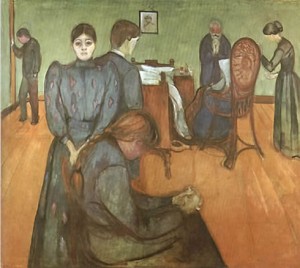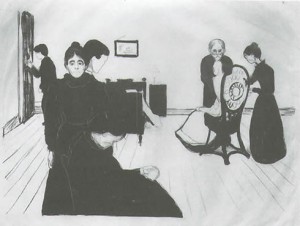Edvard Munch's Death in the Sick Chamber
Edvard Munch’s painting “Death in the Sick Chamber” (1895) portrays death as expressed through the survivors. A striking aspect of this work is that all the people in the room do not console one another and are physically and emotionally isolated.
In “Modern Art and Death”, Carla Gottlieb writes:
….the faces are contorted, not in mourning for a beloved lost member, but in fear of the unknown which has just swallowed the deceased, fear for themselves who are eventually to meet the same fate. In this agony, each person is alone; each survivor turns away not only from the dead but also from the other participants in the scene. Faced with death, the family bonds fall apart, revealing their superficial character. Thus Munch experienced death as dissolving family ties…
The accompanying black and white lithograph evokes an even bleaker atmosphere, as can be seen in the sunken eyes and grim mouth of the woman facing the viewer.
Munch shows the destabilizing and alienating effects of death. Although the people in the room seem to be at a loss how to proceed in life, there is closure. In cryonics such closure is not available. Cryonics also destabilizes the fabric between people because some may survive and others may not. The idea of cryonics can also produce guilt about loved ones who died and never got the chance. These factors, and not just technical feasibility alone, may explain why cryonics is so unpopular.

